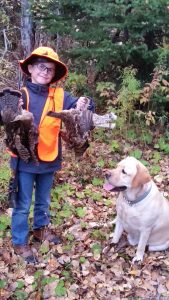Hitting Those Grouse

My late friend, Millinocket guide Wiggie Robinson, loved to ask the question: “What is the difference between a grouse and a pa’tridge?” He would look at you with an impish grin, wait for the dramatic pause and then answer his own question. “If shot in the air it’s a grouse; if shot on the ground it’s a pa’tridge.” Implicit in all of this good-natured repartee, of course, is the knowledge that all is not wing shooting over bird dogs when it comes to gunning grouse.
To each his own. There are upland bird hunters and there are simply meat hunters. Both approaches are legal, but one is irrefutably more sporting and challenging than the other.
Despite years of experience in grouse covers with my own gun dogs and those of others, a good wing shooter I have never been. Shooting grouse on the wing has a lot in common with golf: knowing the correct techniques and converting them to action are two different things.
If you are new at upland bird hunting, or if you are a veteran like me who just never quite got the hang of it, you need to know that the lead is the thing. The late sporting artist and grouse gunner William Harden Foster wrote: “You can’t hit cross-flying grouse if you don’t lead the bird.”
Foster backs up his assertion with some salient points:
1. A grouse shotgun load leaves your shotgun’s barrel at about 900 feet per second
2. The average grouse is going down range at about 70 feet per second.
So the bird shot is only going 12 times faster than the bird. Couple all of this with the fact that it takes the average shooter about a half a second to pull the trigger from the moment the eye sees the target. This does not count the time elapsed between the flush and the bringing up of the gun.
Wing shooting expert Brad Varney, in his new book “Maine-ly Wing Shooting,” has an interesting take on this topic. “Shooting instinctively you should not consciously think. You must look only at the target. The more proficient you become, the less thinking you’ll do, and the less thinking the more proficient you will be.” As I read this, it’s the golfer’s parallel again. Don’t over think it. Rely on muscle memory and just hit the ball – or shoot the bird!
And the fluid, sustained lead on a bird, as with a good golf swing, has follow through.
Foster also insists that “Successful grouse shooting is far more dependent on woodcraft than shooting skill.” What he means is that the high-kill grouse gunners know the bird’s habits and habitat. Once the gun dog is locked up on point the best, more experienced grouse gunners know where to step amid the briars and brambles and how to maneuver for the best shooting position when the thunder flush comes.
Now go practice on some clay targets. October is just around the corner. The grouse outlook is good.
For more articles and stories about hunting, fishing and the outdoors, be sure to subscribe to our monthly publication the Northwoods Sporting Journal.
To access past copies of the Northwoods Sporting Journal in digital format at no charge, click here.
The author is editor of the Northwoods Sporting Journal. He is also a Maine Guide, co-host of a weekly radio program “Maine Outdoors” heard Sundays at 7 p.m. on The Voice of Maine News-Talk Network. His e-mail address is [email protected]. His latest book is “The Maine Angler’s Logbook.”

